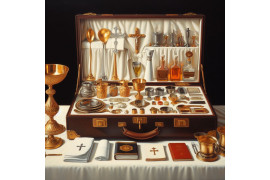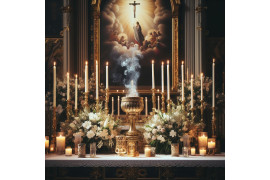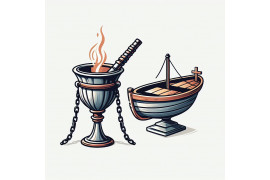The cross symbol holds great significance in Christianity, representing the crucifixion and resurrection of Jesus Christ. It serves as a visual reminder of God's immense love and sacrifice for humanity. Crosses are not just mere decorations; they play a vital role in religious ceremonies and rituals, invoking a deep spiritual connection. Whether worn as jewelry or displayed in churches, the cross symbolizes faith, hope, and salvation.
But have you ever wondered about the meaning behind crosses? We will delve into their historical origins, their various forms and designs, and how they continue to hold deep meaning for believers today. Join us on this journey as we uncover the hidden depths behind the cross symbol.
Different Types of Crosses and Their Historical Context
The meaning of crosses in Christianity goes beyond just a simple symbol. There are various types of crosses, each with its own historical background and cultural significance within the religion. Let's explore some of these different types and delve into their rich history.
Latin Cross
The Latin cross is perhaps the most widely recognized type of cross. It consists of a vertical beam intersected by a shorter horizontal beam near the top. This cross is commonly associated with Jesus' crucifixion, symbolizing his sacrifice for humanity. The Latin cross has been used for centuries as a powerful emblem of faith and redemption.
Greek Cross
Another prominent type is the Greek cross, which features four equal arms that intersect at right angles. This design represents balance and harmony, reflecting the belief in Christ's universal message of love and unity. The Greek cross has its roots in early Christianity and can be seen in various architectural structures, such as churches and cathedrals.
Celtic Cross
The Celtic cross combines Christian symbolism with elements of ancient Celtic culture. It typically features a circle intersecting the vertical and horizontal beams, representing eternity or God's infinite love. The intricate knotwork often seen in Celtic designs adds an extra layer of beauty to this type of cross. The Celtic cross holds deep significance in Irish heritage and is often associated with St. Patrick.
Byzantine Cross
Originating from the Byzantine Empire, the Byzantine cross is characterized by its unique shape: three horizontal bars instead of one. The top bar represents the sign placed above Jesus' head during his crucifixion, reading "INRI," which stands for "Jesus Nazarenus Rex Iudaeorum" (Jesus of Nazareth, King of the Jews). This type of cross emphasizes both Jesus' divinity and his role as King.
Russian Orthodox Cross
The Russian Orthodox cross is distinctive due to its slanted lower bar, representing the footrest of the crucifixion cross. This design is often accompanied by a small upper beam, symbolizing the sign placed above Jesus' head. The Russian Orthodox cross is widely used in Eastern Orthodox Christianity and holds great cultural significance in Russia.
These different types of crosses reflect the diversity and rich history of Christian symbolism. Each one carries its own story and meaning, connecting believers to their faith and heritage. Whether it's the Latin cross with its association to Jesus' sacrifice or the Celtic cross intertwining ancient Celtic traditions with Christian beliefs, these crosses serve as powerful reminders of devotion and spirituality.
By understanding the historical context behind each type of cross, we gain a deeper appreciation for their significance within Christianity. They represent centuries of tradition, faith, and cultural influences that have shaped the religion into what it is today.
Exploring the Meaning of the Cross in Christianity
The cross holds a significant meaning in Christianity that goes beyond its physical form. It symbolizes faith, hope, and salvation for believers. Through Jesus' death on the cross, Christians believe that sins are forgiven, and eternal life is granted.
The Cross as a Symbol of Faith, Hope, and Salvation
In Christianity, the cross represents the ultimate act of love and sacrifice. It serves as a powerful reminder of Jesus Christ's crucifixion and resurrection. The cross is a symbol of faith because it signifies belief in Jesus as the Son of God who died for humanity's sins.
Moreover, the cross embodies hope for Christians. It reminds them that through Jesus' sacrifice, they have been redeemed and can find solace in God's grace. The cross offers reassurance that no matter what challenges or trials they face, there is always hope for salvation.
Forgiveness of Sins and Eternal Life
Central to Christian theology is the belief that through Jesus' death on the cross, sins are forgiven. This act of divine grace allows believers to be reconciled with God and experience spiritual renewal. By embracing the message of the cross, Christians acknowledge their need for forgiveness and accept God's offer of redemption.
Furthermore, the cross represents eternal life in Christianity. Believers view Jesus' resurrection from death as a triumph over sin and death itself. The empty tomb signifies victory over mortality and offers assurance that those who follow Christ will also experience eternal life.
Divine Grace and God's Presence
The symbolism behind the cross extends to divine grace – an unmerited favor bestowed upon believers by God. Through Jesus' sacrifice on the cross, Christians believe they receive this grace freely without having to earn it through their own efforts. The cross serves as a constant reminder of God's unconditional love and presence in their lives.
For Christians around the world, wearing or displaying a cross can be a way to express their faith and invite God's blessings. It serves as a visible sign of their commitment to follow Jesus and live according to his teachings.
The Crucifixion and Resurrection: Key Events Shaping the Cross's Meaning
The crucifixion, which refers to Jesus' execution on a wooden cross by Roman authorities, holds immense significance in Christian theology. It is considered a pivotal event that demonstrates Jesus' ultimate sacrifice for the redemption of humanity.
The story of the crucifixion marks the beginning of a new life for believers. Jesus willingly endured immense suffering and death on the cross as an act of love and salvation. This act exemplifies his selflessness and serves as a powerful symbol of hope and forgiveness.
The crux of the matter lies in understanding the profound meaning behind this event. The crucifixion reveals God's unconditional love for humanity, as well as our need for repentance and reconciliation with Him. It emphasizes that no matter how broken or sinful we may be, there is always an opportunity for redemption through faith in Jesus Christ.
The resurrection plays a vital role in shaping the meaning associated with the cross. After being crucified, Jesus triumphantly rose from the dead on the third day, conquering death itself. This miraculous event signifies not only Jesus' divinity, but also His victory over sin and eternal life offered to all who believe in Him.
The resurrection brings deeper significance to the symbolism associated with the cross. It represents hope, transformation, and new beginnings. Through His resurrection, Jesus offers believers assurance that they too can experience spiritual rebirth and have eternal life with Him.
When considering the meaning of crosses within Christianity, it is essential to understand that they come in various forms beyond just physical representations. The word "cross" can also be used metaphorically to describe challenges or burdens one must bear in their own lives.
For Christians, carrying their cross means embracing difficulties while relying on God's strength and guidance throughout their journey of faith. It serves as a reminder to persevere through trials with unwavering trust in God's plan.
Unpacking the Symbolism Behind the Cross in Christian Faith
The cross is a powerful symbol in the Christian faith, representing the central message of love and sacrifice. Let's delve into the meaning behind this iconic symbol and what it signifies for believers.
Vertical Line: Our Relationship with God
The vertical line of the cross holds significant symbolism. It represents our relationship with God, reaching from earth to heaven. This line reminds Christians of their connection to a higher power and serves as a reminder of divine love.
Horizontal Line: Our Relationships with Others
On the other hand, the horizontal line of the cross symbolizes our relationships with others. It signifies human love and emphasizes the importance of loving one's neighbors. This aspect of the cross reminds Christians that their faith should not only be focused on their relationship with God, but also on how they treat and interact with fellow human beings.
Divine Love (Vertical) and Human Love (Horizontal)
When both lines intersect, they create a unique shape that embodies both divine love (vertical) and human love (horizontal). This intersection acts as a visual representation of the message that Christians are called to embody—loving God wholeheartedly while also extending love and compassion towards others.
The Message Behind the Cross
The symbolism behind the cross sends a powerful message to believers. It serves as a constant reminder to prioritize their relationship with God while also living out their faith through acts of kindness, compassion, forgiveness, and selflessness towards others.
A Reminder to Love Wholeheartedly
For Christians, seeing or wearing a cross can serve as an everyday reminder to live out their faith by loving wholeheartedly. It prompts them to reflect on Jesus' teachings about loving one another as He loved them.
Embodying Christ's Sacrifice
Moreover, when contemplating the meaning behind the cross, Christians are reminded of Jesus' ultimate act of sacrifice on behalf of humanity. The crucifixion and resurrection are central events in the Christian faith, demonstrating Jesus' selfless love and redemption. The cross symbolizes this sacrifice and serves as a visual representation of Christ's victory over sin and death.
A Symbol of Hope
The cross also represents hope for Christians. It is a symbol that reminds them of the promise of eternal life through their faith in Jesus Christ. It offers comfort during times of hardship, reminding believers that they are never alone and that there is always hope even in the darkest of circumstances.
The Cross as a Representation of Sacrifice and Redemption
The image of Jesus on the cross embodies selflessness, sacrifice, and atonement for humanity's sins. It serves as a constant reminder of the immense love and mercy of God towards humankind. The cross represents the path to redemption and offers hope for forgiveness and eternal life.
Selflessness, Sacrifice, and Atonement
The cross is shaped like a crucifix, with Jesus Christ depicted hanging from it. This representation signifies selflessness, as Jesus willingly sacrificed himself for the salvation of humanity. He took upon himself the burden of sin so that others might be forgiven. The suffering endured by Jesus on the cross is seen as an act of atonement for the sins committed by mankind.
Love and Mercy
The image of Jesus on the cross displays God's boundless love and mercy towards humanity. It symbolizes God's willingness to forgive sins and offer redemption to those who seek it sincerely. The crucifixion demonstrates that no matter how grave our transgressions may be, there is always hope for forgiveness through faith in Jesus Christ.
Path to Redemption
For Christians, the cross represents the path to redemption. It serves as a reminder that through belief in Jesus' sacrificial death and resurrection, individuals can find salvation from their sins. By embracing Christ's teachings and following his example, believers can strive towards leading righteous lives that are pleasing to God.
Hope for Forgiveness and Eternal Life
The cross offers hope for forgiveness and eternal life in God's kingdom. Through faith in Jesus' sacrifice on the cross, Christians believe they can receive forgiveness for their sins and attain eternal life in heaven. It provides comfort during times of struggle or guilt, reminding believers that they have been redeemed through Christ's ultimate sacrifice.
Historical Significance
The use of crosses as religious symbols predates Christianity itself. In ancient times, crosses were used in various cultures and regions, such as the ankh symbol in Egypt and the patriarchal cross in the Byzantine Empire. However, it was during the Middle Ages that the crucifix became a central symbol of Christian worship.
Symbolism in Art and Architecture
The cross is prominently featured in churches, cathedrals, and religious artwork. Its presence serves as a visual reminder of Jesus' sacrifice and the central tenets of Christianity. In medieval times, knights often displayed crosses on their shields or banners as a sign of their faith and commitment to defending Christian values.
Variations of Crosses
There are different types of crosses with unique designs and meanings. The Latin cross, with its vertical and horizontal bars intersecting near the top, is perhaps the most recognizable. Other variations include the Greek cross (with equal-length arms), the Celtic cross (with a circular ring around the intersection), and the Chi-Rho cross (with a superimposed "P" over an "X," representing Christ).
Reflecting on the Profound Meaning of Crosses in Christianity
We explored different types of crosses and their historical context, examined the significance of the cross in Christian faith, and unpacked its symbolism as a representation of sacrifice and redemption. We discussed key events such as the crucifixion and resurrection that have shaped the cross's meaning.
By understanding the rich history and symbolism associated with crosses in Christianity, individuals can gain a deeper appreciation for this iconic symbol. The cross serves as a reminder of Jesus Christ's ultimate sacrifice for humanity's salvation and represents hope, forgiveness, and eternal life. Its presence within churches, artwork, jewelry, and religious ceremonies reflects its enduring importance to believers worldwide.
To continue your exploration of Christian symbolism or to learn more about related topics such as religious art or theological concepts, we encourage you to further explore reputable sources or engage with experts in these fields. By deepening your knowledge and understanding of these subjects, you can enrich your spiritual journey and foster meaningful connections within your faith community.
FAQs
What are some other symbols commonly associated with Christianity?
Christianity incorporates various symbols that hold significant meanings for believers. Some common symbols include the fish (ichthys), representing Jesus Christ; the dove, symbolizing peace and the Holy Spirit; the lamb, signifying Jesus as the sacrificial Lamb of God; and the Alpha and Omega (☧), representing Christ's eternal nature.
Is wearing a cross necklace only a fashion statement?
While some people may wear a cross necklace solely for fashion purposes or personal style preferences, many individuals wear it as an expression of their Christian faith. Wearing a cross necklace can serve as a visible reminder of one's beliefs or act as an opportunity to share their faith with others.
Can non-Christians wear crosses?
Yes! Wearing a cross is not limited to Christians alone. Crosses have transcended religious boundaries and are worn by people of various faiths or even as a symbol of cultural heritage. However, it is always respectful to be mindful of the significance the cross holds for different religious groups.
Are all crosses in Christianity the same?
No, there are various types of crosses within Christianity, each with its own unique design and symbolism. Some common examples include the Latin cross, Greek cross, Celtic cross, and crucifix. These variations often reflect different historical periods or cultural influences.
How can I learn more about Christian symbolism?
To deepen your understanding of Christian symbolism, you can explore theological texts, visit museums or art galleries featuring religious art, attend lectures or workshops on the subject, or engage in discussions with knowledgeable individuals such as theologians or clergy members. Reputable online resources and academic publications can provide valuable insights into this fascinating topic.



